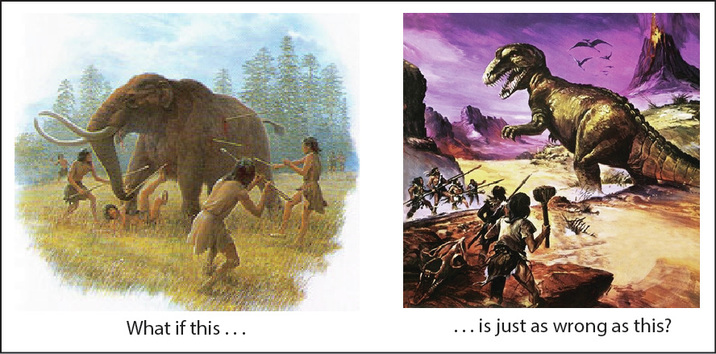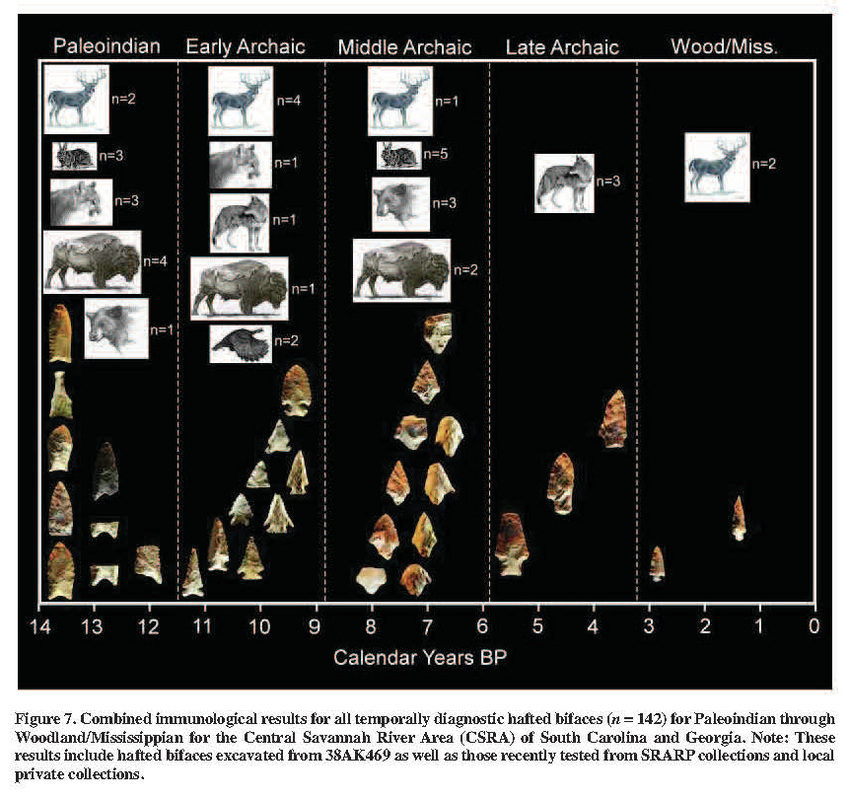|
If you're interested in pseudoarchaeology, you probably know that Graham Hancock's new book America Before is now out. I haven't read it yet. I will probably take at stab at it at some point over the summer, but I have to face the reality that I'm just not excited. My lack of enthusiasm stems mostly, I think, from a gut feeling that there is not a whole lot in the book that is particularly new, thought-provoking, or even interesting. The summary reviews I have read so far bear that out (you can read Jason Colavito's review here, and Carl Feagan's take here). I already knew Hancock was going to going to claim that a comet wiped out some kind of fantastical "advanced civilization" that existed during the Ice Age, and I already knew that he would try to connect his claim to the archaeology of North America in whatever ways possible. I predict anyone who has any legitimate expertise in this region of the world can see through Hancock's game in two seconds. I guess if you're blissfully ignorant maybe it all sounds very exciting . . . I wouldn't know: as someone who has been doing real archaeology in North America for 25 years now I can hear the sound of this book ringing hollow before I even crack the cover.
What if the Clovis adaptation in the Eastern Woodlands had nothing substantive whatsoever to do with mammoths and mastodons?
What if all of those dioramas and illustrations of Paleoindian peoples swarming a mastodon mired in the muck are complete baloney? What if one of our most popular baseline notions about Clovis in the east is totally wrong?
The thought isn't an original one, of course, but one that I've been thinking about since listening to a presentation by Christopher Moore (SCIAA colleague) at the Archaeological Society of South Carolina (ASSC) meeting on Saturday. Moore is the senior author of a recent American Antiquity paper (which is unfortunately behind a paywall) that presents protein residue analysis of 142 hafted bifaces (i.e., stone projectile points/knives) from the Savannah River area of South Carolina and Georgia. Protein residue analysis uses chemical tests to identify trace residues left on stone tools through contact with the blood of various groups of animals.
Here is a summary figure from the published paper:
The results that Moore et al. present are striking for two main reasons. First, there is positive evidence for the exploitation of bison in the region during the Paleoindian through Middle Archaic periods. Second, there are no indications that any of the Paleoindian tools they examined were involved with processing proboscideans (i.e., mammoths and mastodons).
As explained in the American Antiquity paper, the positive evidence for bison populations in the region in the Late Pleistocene is consistent with several other data points (including previous protein residue studies and radiocarbon-dated remains such as the Wacissa bison). The new residue data also support the continued presence of bison in the region into the mid-Holocene. That's pretty interesting to me, as it suggests that the exploitation of a large game animal that is more-or-less invisible in the faunal records (both archaeological and natural) may have been important to the food economies of the Archaic peoples I'm keenly interested in understanding. And what about the absence of hits for proboscidean? That's pretty interesting as well. Near the end of his ASSC presentation, Moore informally posed a great "what if" question (and I'm paraphrasing here): what if the evidence for human involvement with mammoths/mastodons in eastern North America actually pertains to pre-Clovis rather than Clovis peoples? For me, pondering that question was one of those nice "wait a @#!%*$# second . . ." moments that happens every so often in science. What if we have not just exaggerated the embrace between Clovis and megafauna in the east, but allowed our romantic notions (and the very clear evidence of Clovis-age megafaunal predation in the west) to blind us to the real pattern that's present? Impossible, you say? Let's ask a series of questions. I'll give you the answers based on what I know off the top of my head and what I have time to assemble on Monday morning of a busy week. Please correct me if I'm wrong on something or help me add things I've left out -- I'm not making any claim that this listing of evidence is exhaustive. Note: when I say "eastern North America" I mean east of the Mississippi River. Question: Are there any direct associations between Clovis stone tools and mammoth/mastodon remains in eastern North America? Answer: No. As far as I know, Kimmswick (Missouri) is the farthest east Clovis-associated megafaunal kill site. Question: Are there any human-butchered mastodon/mammoth remains in eastern North America that have been dated to the Clovis period (i.e., 11,050-10,800 radiocarbon years before present [RCYBP]; ~13,250-12,800 Calendar years before present; ~11,300-10,850 BC)? Answer: Not that I know of off the top of my head. The eastern cases of purported mastodon/mammoth butchery of which I am aware pre-date the known age range of Clovis. Here are some examples:
Question: Is there any direct evidence that mammoths/mastodons survived into Clovis times in eastern North America? Answer: Yes. There are directly-dated mammoth and mastodon remains that demonstrate that proboscideans survived into and beyond Clovis times. The period 10,500-10,000 RCYBP (i.e., post Clovis) is probably a reasonable extinction window for mastodons in the east. Here, for example, is a report of a mastodon from northern Indiana dated to about 10,000 RCYBP. Question: Is there any direct evidence that Clovis peoples used parts of mammoths/mastodons obtained from recently deceased animals? Answer: Yes, apparently. There are ivory and bone tools from Florida that are attributed to Clovis. Here is a quote from a paper by Bruce Bradley:
"While most of the known specimens were recovered from stratigraphically mixed deposits, recent archaeological excavations have found them in late Pleistocene deposits directly associated with extinct fauna, including mammoth and mastodon. Flaked stone projectile points and other tools are also associated with these artifacts. Projectile point types commonly include Clovis fluted and Suwanee."
I don't have the time to delve into the literature right now and investigate the nature of the associations between the ivory tools and the Paleoindian points, or to see if any of the ivory tools have been directly dated.
So there you go.
It seems pretty clear that Clovis peoples existed on the landscape (or were at least present in eastern North America at the same time) as proboscideans. They apparently used parts of those animals to fashion tools. But the case for active Clovis-age predation of mammoths and mastodons continues to be based on circumstantial evidence. As more and more purported proboscidean butchery sites of pre-Clovis age are reported from the Eastern Woodlands, it seems less likely that the east-west contrast in megafaunal kill sites is solely the result of a preservation bias: it's not the elephants that are missing, but the direct evidence that Clovis peoples hunted them. If we take mammoths and mastodons out of the Clovis picture, there's a lot of explaining to do. What was the point of all that beautiful technology? I was one of several junior co-authors on a paper (Speth et al. 2013) that attempted a political re-imagining of Early Paleoindian fluted point technologies. While I'm not convinced by all the arguments in that paper, I think it was a useful exercise. There are other alternatives to the dominant "Clovis meat machine" model that can be constructed. And what if bison was an important game animal in some portions of the Eastern Woodlands into the Middle Archaic? What if bone preservation issues really are part of the problem for our interpretations of the Early and Middle Holocene and we've been unable to see (and therefore to factor into our models) a large herbivore that may have been a huge part of the subsistence economies of early hunting-gathering societies in the region? That deserves a very hard look. I've used all the time I can spare to write about this today. I'm hoping some of you find this question interesting and point out things I'm not aware of. I'll be returning to this as I have time - it's a pretty cool set of questions to think about.
Moore, C., Brooks, M., Kimball, L., Newman, M., & Kooyman, B. (2016). Early Hunter-Gatherer Tool Use and Animal Exploitation: Protein and Microwear Evidence from the Central Savannah River Valley American Antiquity, 81 (1), 132-147 DOI: 10.7183/0002-7316.81.1.132
|
All views expressed in my blog posts are my own. The views of those that comment are their own. That's how it works.
I reserve the right to take down comments that I deem to be defamatory or harassing. Andy White
Email me: [email protected] Sick of the woo? Want to help keep honest and open dialogue about pseudo-archaeology on the internet? Please consider contributing to Woo War Two.
Follow updates on posts related to giants on the Modern Mythology of Giants page on Facebook.
Archives
January 2024
Categories
All
|





 RSS Feed
RSS Feed
